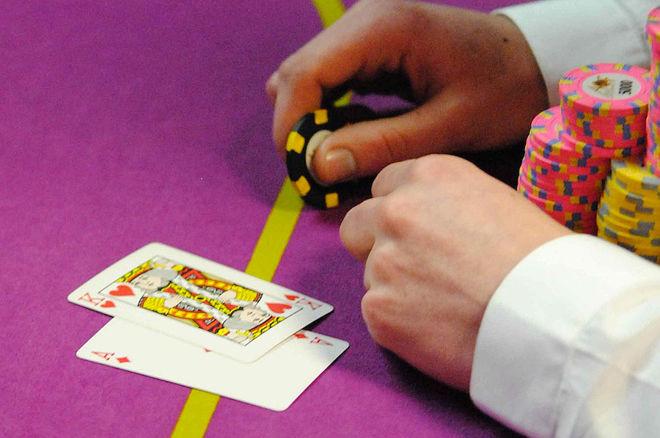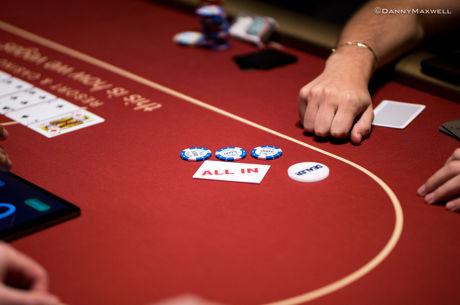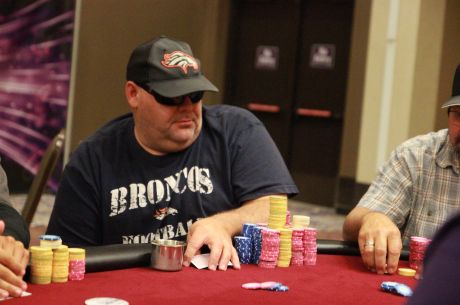Learning How to Read Your Own Range; or, Think With Your Hands

When making a postflop decision, it's important that you think not just about what poker hands your opponent could have, but also about your own range. Think of the strongest hand you can have in a given spot. Think of the weakest. Now look at the hand you actually have. Where along the way does it lie?
If we think of the times you raise the button, maybe your range starts at pocket aces and ends at 10x8x-offsuit or 5x4x-suited. From there we can surmise that defending versus a three-bet with, say, 10x9x-offsuit is by no means mandatory. We can use a similar train of thought in more complicated spots.
Let's look at an actual hand of online poker from a game of 100NL six-handed Zoom that helps illustrate the importance of reading your own range.
Action From the Start
With the blinds $0.50/$1, a regular sitting under the gun raised to $3 and was three-bet by the cutoff to $9. It folded around and that regular called. Heads-up to a flop in a three-bet pot.
The first three board cards came A?7?6?. The UTG player checked, the cutoff bet $10.50, UTG check-raised to $21, and the cutoff called. On an ace-high board that could hit the cutoff's flop betting range well, strength has been shown.
Where Is Ace-King Now?
The turn card was the 9?. If we think of the cutoff's range, AxKx was near the top of it both before the flop and after. But on this turn card, not all AxKx combinations can be valued equally.
On the flop, A?K? (for example) was arguably the best ace-king of the bunch. Now on the 9? turn that hand is as weak as A?K?. Meanwhile A?K?, A?K?, and A?K? all remain near the top of the cutoff's range, while the rest of the ace-king combinations fall by the wayside.
If the cutoff can hold K?Q? preflop, that hand now hurdles everything to the top. Pocket aces remains strong of course, but no longer occupies the top-of-the-range position.
Preflop bluffs that connected well �� e.g., A?7?, A?6?, or 7?6? �� are substantially diminished on this turn card. By contrast, other hands like 5?4? and 10?8? leap forward.
The fact is, every combination moves up or down the ladder depending on what fourth street brings. Only on a 2x, Jx, Qx, or Kx (or the case ace) would pocket aces still be the nuts on the turn.
This consideration of the cutoff's range has very practical consequences for the hand in question. That's because the check-raiser sitting UTG decided to pot it, betting $60 into $60 with $95 behind.
A Line in the Sand
If A?K? is no longer near the top of the cutoff's range, as it once was, need he call this pot-sized turn bet with it? The answer is simply no.
The problem with A?K? is not just that it is no longer that strong, it also can't really improve �� when it is behind on this A?7?6?9? board it is drawing dead almost always. That means it cannot find any good rivers to call. Think about it �� after that flop check-raise and pot-sized turn bet from UTG, which hands does A?K? beat on a K? river? Not sets, not straights, not flushes.
We also see in this instance the value of not three-betting the flop with one's strongest hands, but also with weaker flush draws. If the cutoff had done so, he'd be trying to sort out whether he could really let go of A?K? here on this turn. His range would have been unprotected by flushes and straights. Also demonstrated here is the value in three-betting preflop a ranged mixed of high cards and high pairs with suited connectors that can make straights or flushes in this type of situation.
One might argue, though, that to call this bet would not necessarily lead to being pot committed �� in other words, that calling A?K? on the turn to fold the river is viable. But this is only reasonable if we expect the river shoving frequency of the UTG player to be low after he check-raised flop and potted turn. That's unlikely. It is also needs to be true that A?K? can win at showdown on a river check-check, which could or could not be.
Get to the Point
The cutoff player did call the pot-sized turn bet, then the river brought the J? �� definitely a blank. UTG responded by shoving all in with his set �� 7?7? �� and the cutoff called with A?K?, getting stacked for a nearly 400-big blind pot.
The cutoff probably felt coolered. Of course, getting stacked with the three AxKx combinations that include the K? would have been much more justifiable �� he would have had outs on the turn and would have blocked flushes on the river. Meanwhile AxAx could have made this river call unhappily and gotten stacked by straights and flushes, but still win the times UTG flops a set as in this hand.
The point is that had the turn card been the J? everything would be different for cutoff. But he got married to a hand with the attractive name of "top pair, top kicker" instead of looking at how that hand fit into the full view of his entire range.









